IMPERIAL JEWELS OF CHINA
NOVEMBER 3-14, 2007


(Please click on any picture to enlarge it.)
NOVEMBER 3-4
NEW YORK * VANCOUVER * SHANGHAI
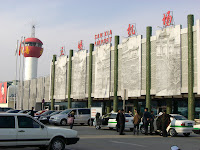 Left JFK via Air Canada flight AC549 AT 7:30 am, arrived in Vancouver at 10:40 am, left Vancouver at 12:50 pm and arrived in Shanghai at 4:30 pm the next day. Checked in at the St. Regis Hotel, quite pleased with the accomodations.
Left JFK via Air Canada flight AC549 AT 7:30 am, arrived in Vancouver at 10:40 am, left Vancouver at 12:50 pm and arrived in Shanghai at 4:30 pm the next day. Checked in at the St. Regis Hotel, quite pleased with the accomodations.NOVEMBER 5
SHANGHAI
THE BUND
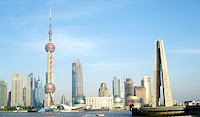 After a nice buffet breakfast at the hotel, we toured the Bund along the Huangpu River, gazing at the various architectural styles.
After a nice buffet breakfast at the hotel, we toured the Bund along the Huangpu River, gazing at the various architectural styles.
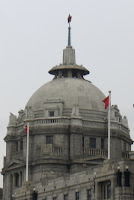

SHANGHAI MUSEUM
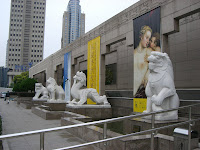 Next stop was the Shanghai Museum with its amazing collection of ancient bronzes, ceramics, paintings, sculptures and calligraphy.
Next stop was the Shanghai Museum with its amazing collection of ancient bronzes, ceramics, paintings, sculptures and calligraphy.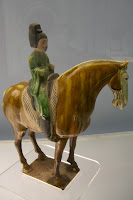

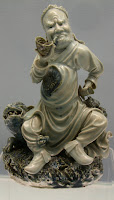
SILK CARPET WORKSHOP
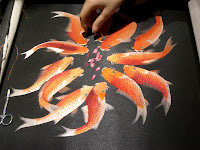 Next was a visit to a local silk carpet workshop where we saw a demonstration of carpet weaving. I was amazed at the wonderful silk carpets with their beautiful designs.
Next was a visit to a local silk carpet workshop where we saw a demonstration of carpet weaving. I was amazed at the wonderful silk carpets with their beautiful designs.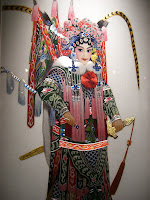
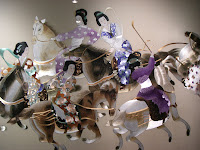
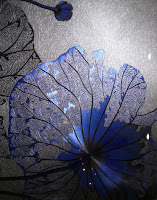

OLD SHANGHAI
 After lunch which was at a local restaurant, we walked in Old Shanghai and browsed at several interesting shops. There was a teahouse in the middle of a big pond filled with koi.
After lunch which was at a local restaurant, we walked in Old Shanghai and browsed at several interesting shops. There was a teahouse in the middle of a big pond filled with koi.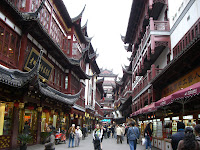 Old Shanghai with its narrow lanes was packed with tourist shops.
Old Shanghai with its narrow lanes was packed with tourist shops.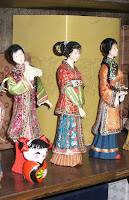

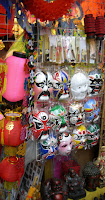
YUYUAN GARDENS
 The Yuyuan Gardens was built during the Ming Dynasty with a few acres of pavillions, winding paths, caves, grottoes, and even an artificial mountain.
The Yuyuan Gardens was built during the Ming Dynasty with a few acres of pavillions, winding paths, caves, grottoes, and even an artificial mountain.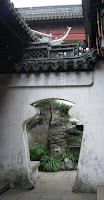

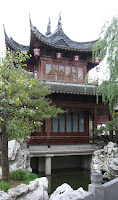
Dinner was at a nice Chinese restaurant and then to the theatre to watch the famous Shanghai acrobats.
NOVEMBER 6
SHANGHAI * YICHANG * MAOPING
 Spent the morning leisurely at the hotel spa before lunch at a local restaurant on the way to the airport for a flight to Yichang and to the Viking Century Sky, docked in Maoping.
Spent the morning leisurely at the hotel spa before lunch at a local restaurant on the way to the airport for a flight to Yichang and to the Viking Century Sky, docked in Maoping.
Onboard the ship we enjoyed cocktails in the Observation Lounge and later enjoyed dinner prepared by Chef de Cuisine Olaf Grams. Maitre d'Hotel Oliver Geiger was attentive to all the guests. Live Jazz music was played by musicians Todor and Madeleine.
NOVEMBER 7
THREE GORGES DAM * XILING GORGE
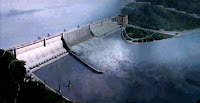 This morning we visited the Three Gorges Dam, the largest hydroelectric dam in the world which spans the Yangtze River.
This morning we visited the Three Gorges Dam, the largest hydroelectric dam in the world which spans the Yangtze River.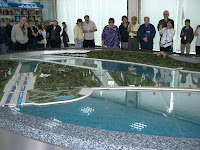
Sun Yat-sen envisioned the dam in 1919 and Chiang Kai-shek began plans in 1932. In 1992 Li Peng had the plan approved. Construction started in December 1994 and should be fully operational in 2011.
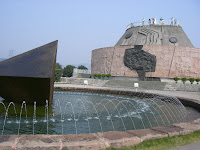 Also visited the park by the Three Gorges Dam.
Also visited the park by the Three Gorges Dam. Went back to the ship for lunch and in the afternoon there was a lecture about "Yangtze - the River of Life". The Viking Century Sky left Maoping and set sail for Badong which is about 50 miles away.
Went back to the ship for lunch and in the afternoon there was a lecture about "Yangtze - the River of Life". The Viking Century Sky left Maoping and set sail for Badong which is about 50 miles away.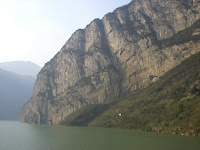 The view from our little balcony of Xiling, the longest of the Three Gorges, was spectacular.
The view from our little balcony of Xiling, the longest of the Three Gorges, was spectacular.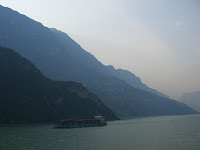 Went up to the Observation deck to get more panoramic views of Xiling.
Went up to the Observation deck to get more panoramic views of Xiling. A spectacular view of misty mountains and breathtaking gorge.
A spectacular view of misty mountains and breathtaking gorge.Activities onboard were Chinese language lesson followed by cocktails with Captain Gao. Chinese dinner was prepared by Chinese chef Leon Zhang from a menu designed by Martin Yan, a renowned Hong Kong chef famous for his American TV cooking show. A music concert by the onboard bands, Chinese Sky and Madeleine Duo, followed at the Observation Lounge.
NOVEMBER 8
WU GORGE * LESSER THREE GORGES * QUTANG GORGE
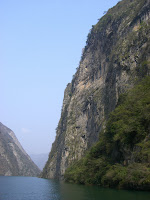 After breakfast I watched Master Huang teach Tai Chi on the Sun Deck. Then we sailed through beautiful Wu Gorge, passing by lush mountains including the legendary Twelve Peaks, enveloped with mist.
After breakfast I watched Master Huang teach Tai Chi on the Sun Deck. Then we sailed through beautiful Wu Gorge, passing by lush mountains including the legendary Twelve Peaks, enveloped with mist. Midmorning we changed to a smaller boat for a shore excursion on the Daning River into the Lesser Three Gorges which are inaccessible by larger vessels.
Midmorning we changed to a smaller boat for a shore excursion on the Daning River into the Lesser Three Gorges which are inaccessible by larger vessels.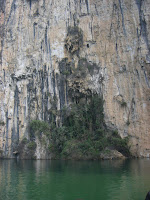

 Sheer cliffs line the river. Picture shows what seems to be like charcoal drawings on the face of the cliff.
Sheer cliffs line the river. Picture shows what seems to be like charcoal drawings on the face of the cliff.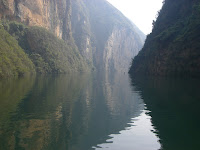 Among the unbelievable sights along these gorges were the hanging coffins of the Ba people, a Chinese ethnic group, which were hundreds of feet high on the sheer cliffs.
Among the unbelievable sights along these gorges were the hanging coffins of the Ba people, a Chinese ethnic group, which were hundreds of feet high on the sheer cliffs. A sumptuous picnic lunch, prepared by the ship's chef, was served on the riverbank along the Yangtze.
A sumptuous picnic lunch, prepared by the ship's chef, was served on the riverbank along the Yangtze. Delicacies being sold by vendors where we stopped for our picnic lunch.
Delicacies being sold by vendors where we stopped for our picnic lunch.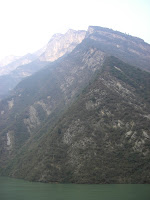 We returned to the ship and sailed through Qutang Gorge, the shortest and narrowest of the gorges.
We returned to the ship and sailed through Qutang Gorge, the shortest and narrowest of the gorges.NOVEMBER 9
SNOW JADE CAVE * FENGDU
 This morning's shore excursion was a choice between the new town of Fengdu or the Snowy Jade Cave. I chose the cave and it turned out to be a wonderland of breathtaking limestone formations...
This morning's shore excursion was a choice between the new town of Fengdu or the Snowy Jade Cave. I chose the cave and it turned out to be a wonderland of breathtaking limestone formations...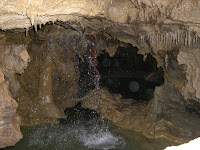 ...and colorful pools. The cave was formed some 56,000 years ago but found only in 2005 by local farmers.
...and colorful pools. The cave was formed some 56,000 years ago but found only in 2005 by local farmers.Upon returning to the ship, we set sail for Chongqing, 111 miles away. There was a mahjong lesson in the afternoon.
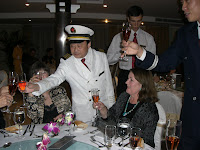 Tonight is the Captain's Dinner. Captain Gao, between Valerie and Irene, toasting at our table.
Tonight is the Captain's Dinner. Captain Gao, between Valerie and Irene, toasting at our table.Below pictures show Val and me, Irene with her favorite bartender, and Berrell.

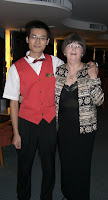

 The fabulous Crew Cabaret Show followed with the amazing crew performing musical numbers...
The fabulous Crew Cabaret Show followed with the amazing crew performing musical numbers...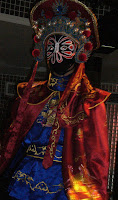
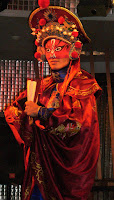 ...and the incredible, lightning-speed
...and the incredible, lightning-speedmask-changing performance.
NOVEMBER 10
CHONGQING * XIAN
We disembarked this morning and toured Chongqing, which is at the confluence of the Yangtze and the Jialing River, in Sichuan Province.

We visited the Chongqing Zoo and saw the loveable giant panda bears.

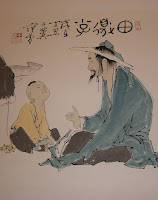 A stop at a Chinese artshop then lunch at the Chongqing Carlton Hotel.
A stop at a Chinese artshop then lunch at the Chongqing Carlton Hotel.
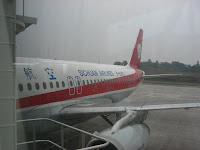 Flew Sichuan Airlines to Xian in Shaanxi province, a major ancient civilization capital and China's key city of the Tang Dynasty, 618-907 A.D. Checked in at the Shangri-La Golden Flower Hotel.
Flew Sichuan Airlines to Xian in Shaanxi province, a major ancient civilization capital and China's key city of the Tang Dynasty, 618-907 A.D. Checked in at the Shangri-La Golden Flower Hotel. Entertainment tonight was at an opulent theatre/restaurant.
Entertainment tonight was at an opulent theatre/restaurant.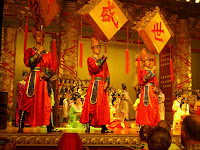 We were regaled with Tang Dynasty grandeur...
We were regaled with Tang Dynasty grandeur... ...in historic songs...
...in historic songs...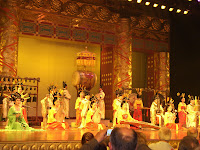 ...and dances.
...and dances.NOVEMBER 11
XIAN * BEIJING
 This morning we visited the site where Xian's incredible Terracotta Army was discovered in 1974 by local farmers.
This morning we visited the site where Xian's incredible Terracotta Army was discovered in 1974 by local farmers.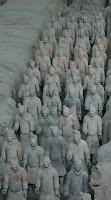
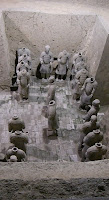

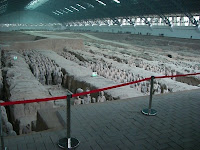 Thousands of these terracotta figures were buried with the first Qin Emperor Shi Huang Di. The figures vary in height (6 to 6 ft, 5 in.) according to their role, the tallest being the generals.
Thousands of these terracotta figures were buried with the first Qin Emperor Shi Huang Di. The figures vary in height (6 to 6 ft, 5 in.) according to their role, the tallest being the generals.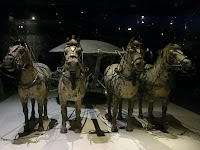 The figures include warriors, chariots, horses, officials, acrobats, strongmen, and musicians. They've estimated 8,000 soldiers, 130 chariots with 520 horses, and 150 cavalry horses, most are still buried in the three pits.
The figures include warriors, chariots, horses, officials, acrobats, strongmen, and musicians. They've estimated 8,000 soldiers, 130 chariots with 520 horses, and 150 cavalry horses, most are still buried in the three pits.After lunch we flew to Beijing where we checked in at the Westin Hotel.
NOVEMBER 12
GREAT WALL * SACRED WAY OF THE MING TOMBS
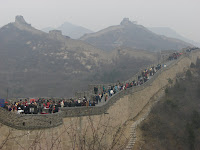 We went to the Badaling Hills to walk on the fabled Great Wall, a UNESCO World Heritage Site, built between the 5th century BC to the 16th century. It stretches to over 4,000 miles.
We went to the Badaling Hills to walk on the fabled Great Wall, a UNESCO World Heritage Site, built between the 5th century BC to the 16th century. It stretches to over 4,000 miles.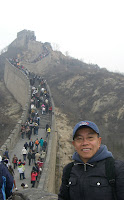

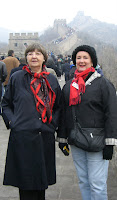
Next we went to the Sacred Way of the Ming Tombs, the burial place of 13 Ming Dynasty emperors, starting with Emperor Yongle. The Ming Tombs were listed as a UNESCO World Heritage Site in August 2003.
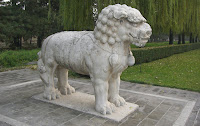 The long avenue leading to the gateway is lined with 18 pairs of massive stone sculptures of elephants, lions, camels, and mythical beasts.
The long avenue leading to the gateway is lined with 18 pairs of massive stone sculptures of elephants, lions, camels, and mythical beasts.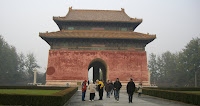 The Great Red Gate.
The Great Red Gate. This giant turtle is inside the Great Red Gate.
This giant turtle is inside the Great Red Gate.NOVEMBER 13
TIANANMEN SQUARE * FORBIDDEN CITY * SUMMER PALACE * FAREWELL DINNER/PEKING OPERA
TIANANMEN SQUARE
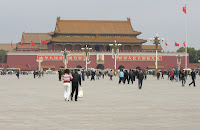 Tiananmen Square was the site of the proclamation of the People's Republic of China by Mao Zedong on October 1, 1949 and the protests of 1989 which resulted in the massacre of protesters.
Tiananmen Square was the site of the proclamation of the People's Republic of China by Mao Zedong on October 1, 1949 and the protests of 1989 which resulted in the massacre of protesters.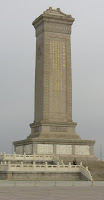
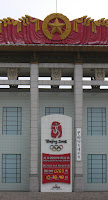
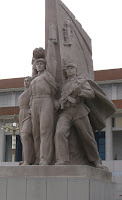
FORBIDDEN CITY
 Forbidden City was the imperial palace from the mid-Ming Dynasty to the end of the Qing Dynasty.
Forbidden City was the imperial palace from the mid-Ming Dynasty to the end of the Qing Dynasty.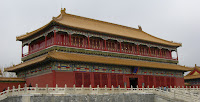 Built from 1406 to 1420 with 980 buildings, 8,707 rooms, it covers 720,000 sq m, the world's largest surviving palace complex.
Built from 1406 to 1420 with 980 buildings, 8,707 rooms, it covers 720,000 sq m, the world's largest surviving palace complex. It was designed to be the center of the ancient, walled city of Beijing. It is enclosed in a larger, walled area called the Imperial City.
It was designed to be the center of the ancient, walled city of Beijing. It is enclosed in a larger, walled area called the Imperial City.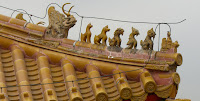 It was declared a UNESCO World Heritage Site in 1987.
It was declared a UNESCO World Heritage Site in 1987.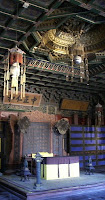
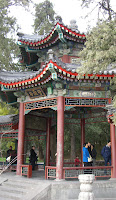
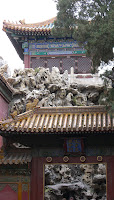
SUMMER PALACE
 The Summer Palace was constructed in the Jin Dynasty (1115-1234) and by the time of the Qing Dynasty (1644-1911), it has become a luxurious royal garden.
The Summer Palace was constructed in the Jin Dynasty (1115-1234) and by the time of the Qing Dynasty (1644-1911), it has become a luxurious royal garden.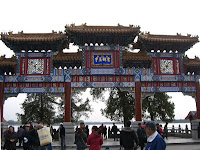 In 1888 Empress Dowager Cixi embezzled navy funds to reconstruct it for her own benefit, changing its name to Yiheyuan (Summer Palace). After the 1911 revolution, it was opened to the public.
In 1888 Empress Dowager Cixi embezzled navy funds to reconstruct it for her own benefit, changing its name to Yiheyuan (Summer Palace). After the 1911 revolution, it was opened to the public.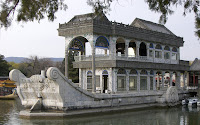 It is composed mainly of Longevity Hill and Kunming Lake. UNESCO declared it a World Heritage Site in 1998.
It is composed mainly of Longevity Hill and Kunming Lake. UNESCO declared it a World Heritage Site in 1998.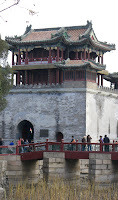


BEIJING OPERA * FAREWELL PEKING DUCK DINNER
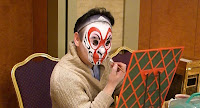 Becoming a Beijing opera performer requires a long and arduous apprenticeship beginning from an early age.
Becoming a Beijing opera performer requires a long and arduous apprenticeship beginning from an early age.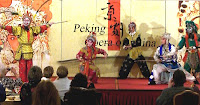 It is regarded that Beijing opera was born in 1790. It was originally staged for the court and came into the public later.
It is regarded that Beijing opera was born in 1790. It was originally staged for the court and came into the public later.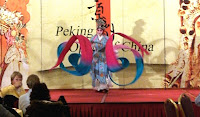 Beijing Opera is a form of traditional Chinese theatre which combines music, vocal performance, mime, dance and acrobatics.
Beijing Opera is a form of traditional Chinese theatre which combines music, vocal performance, mime, dance and acrobatics. Peking Duck is a famous dish that has been prepared since the Yuan Dynasty, and is now considered one of China's national foods.
Peking Duck is a famous dish that has been prepared since the Yuan Dynasty, and is now considered one of China's national foods. A sampling of Beijing Opera and a Farewell Peking Duck Dinner was a nice ending to a wonderful trip.
A sampling of Beijing Opera and a Farewell Peking Duck Dinner was a nice ending to a wonderful trip.NOVEMBER 14
BEIJING * VANCOUVER * NEW YORK CITY
Left Beijing on Air Canada Flight AC30 at 5:30 pm arriving in Vancouver at 12:30 pm then left at 2:30 pm arriving in New York at 5:20 pm on the same day.
The river cruise was terrific; the hotels were all top quality hotels; food was great; the sights were spectacular; and the trip was culturally enlightening. I also met a lot of nice people.













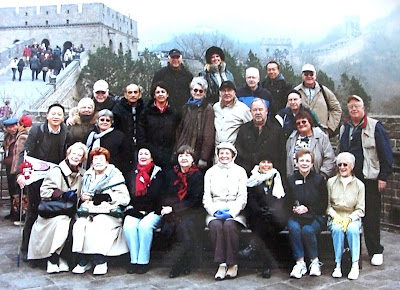
To check my other travel blogs, please click on any trip listed under "My Other Blogs" on the uppermost right hand box above. Thank you for viewing my travel blog.
